
The 2018 Ducati SuperSport S.
The sport-touring segment has always been a difficult one for the motorcycle manufacturers because it covers a wide spectrum of riders who tend to be experienced and demanding. Some are happy to throw some soft saddlebags over the passenger seat of a race replica and look for the curviest route to the destination while others demand full weather protection, shaft drive, an electrically adjustable windscreen, integrated luggage and other features aimed at racking up big miles in speed and comfort.
No single motorcycle could appeal to both.
That challenge has become even more complicated by the popularity of sport-touring motorcycles with adventure-touring style. These combined purely street-oriented gear, such as 17-inch tires in sport sizes, with the upright ergonomics and tall stance of the ADV bikes. Maybe the best example is the Ducati Multistrada.
Two years ago, however, Ducati unveiled the SuperSport, a motorcycle very much in the old tradition of sport-tourers — and very much skewed toward the end of the spectrum where you’d find the guy riding something like a Honda CBR600F4i or a Kawasaki Ninja “636” across multiple state lines with a tail bag and a tank bag strapped on. Minimalist, sport-oriented travel.
While I’m not young enough any more to be that guy, I still lean toward the sport end of sport-touring and I still prefer the old formula — take a sport bike and make it comfortable enough for travel — over the new trend of taking an adventure bike and streetifying it. So when I had the chance to spend a week this summer with a 2018 Ducati SuperSport S, it was a ride I was really looking forward to.

The Ducati SuperSport S was a fun ride for a sunny afternoon on the Pacific Coast Highway. Photo by Lance Oliver.
I picked up a matte white SuperSport S at Ducati N.A. headquarters in Mountain View, California, and rode north through Silicon Valley, where the cars tend to be nicer and Ducatis more numerous than back home. I squeezed through San Francisco right at afternoon rush hour and followed the traffic north to spend the weekend covering the MotoAmerica round at Sonoma Raceway, where I found more traffic congestion that was less expected. I rode some curvy, less crowded roads to shoot some photos with expert moto-photog Brian J. Nelson, then burned down the super-wide freeways east of the Bay and met my wife, who flew out for a couple of days so we could do a leisurely day ride down the Pacific Coast Highway to Big Sur. Finally, I took the most interesting roads I could find on my way back to Mountain View, including a loop up to Alice’s Restaurant.
While all that did not add up to huge miles, I did cover just about all kinds of riding a SuperSport owner might experience: urban streets, urban and suburban freeways, curvy two-lanes and an afternoon of riding two-up.
What exactly is a Ducati SuperSport?
While I initially saw the SuperSport S as a sport-touring bike on the sport end of that spectrum, Ducati positions it as a sport bike with rational ergonomics and performance for the street. Ducati’s description turned out to be the better one. The ergonomics are right where you’d expect for a sport bike made for the street (if ultimate performance on the track is your thing, Ducati has plenty of Panigales to choose from). If you’re coming from a race replica, the SuperSport will feel comfortable. If you’re coming from anything else, it will feel sporty. The handgrips are above the top triple tree clamp and the foot pegs are a bit lower, but it’s still a slightly more sporty position than a Kawasaki Ninja 1000 or a Honda VFR800 Interceptor, to cite two examples of traditional sport-touring machines on the sporty end of the spectrum.
Performance also fits that “rational sport bike” description. The SuperSport is built around the 937 cc 90-degree twin found in other Ducatis but redesigned and retuned for use in this new model. Ducati claims 113 horsepower at 9,000 rpm and 71.3 foot-pounds of torque at 6,500, so the power is more accessible at street speeds than track-focused bikes that want to be revved to five-digit engine speeds.
The differences between the SuperSport and the SuperSport S are few but significant. Power, weight (claimed 463 pounds ready to ride), brakes and dimensions are the same. With the S you get Öhlins suspension front and rear, with a 48 mm inverted fork and monoshock, both fully adjustable. On the base model, you get a 43 mm Marzocchi fork and a Sachs rear shock. The S also comes with DQS, Ducati’s quick shifter system, which allows clutchless up- and downshifts. I did not have the opportunity to ride the base model, so all my riding impressions here refer to the S model.
Mindful that the SuperSport could be used for everything from a long trip to a track day, Ducati gave the bike a very flexible electronic aids package. While some models give you a few preset rider modes and provide one that you can customize to your own specifications, the SuperSport has three modes and you can fine-tune the settings on all three. Basically, you can have three custom maps.
The three modes preset from the factory are Sport, Touring and Urban. Within each, there are four parameters you can control: DTC, Ducati traction control, which has eight levels; ABS, which has three levels plus off; engine power, which can be set to high, medium or low; and DQS, which can be turned off or set to work with upshifts only or both up- and downshifts. This approach gives you a lot of flexibility. For example, while I only rode the bike on the street, the previous riders had taken it to the track and had a pro-level rider test it. He had customized the Sport setting for track use by lowering the DTC to the lowest level of intervention and turning off ABS. An owner could, for example, customize the Sport setting for track days, Touring for daily street riding and Urban for rainy days and perhaps never have to touch the adjustments. All these settings are “sticky,” so you don’t have to make those adjustments every time you start the bike.
If you do want to make fine-tuning changes, it’s not unduly complicated. A button and a toggle on the left hand grip are used to scroll through displays on the dash and change settings. A few minutes with the owner’s manual had me clicking through the menu without much difficulty.
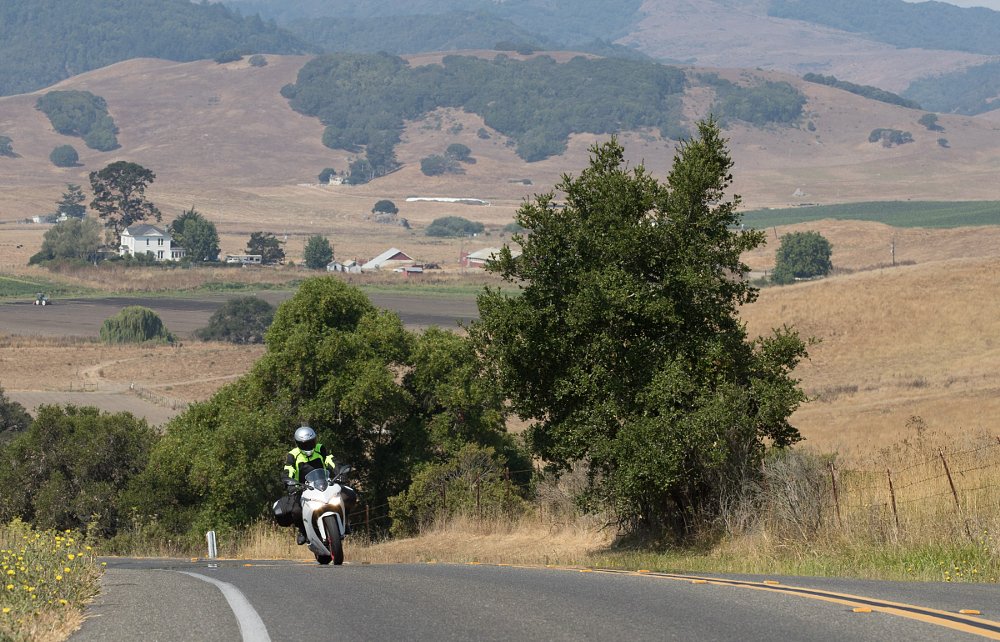
I could go traveling on the Ducati SuperSport S. I pack light. Photo by Brian J. Nelson.
Riding the SuperSport in California
Though Ducati has gone to a V-four engine for both its MotoGP race bike and, as of next year, its flagship Panigale V4 R, which is the basis of its World Superbike entry, the SuperSport carries on Ducati’s long L-twin tradition. And you won’t forget that fact, either. Bring the engine to life and the rumbly note and vibes will never let you forget this is no multi-cylinder engine. The two-into-one-into-two exhaust barks with more volume than I thought any EPA decibel meter would ever allow.
Though the cable-operated clutch is a slip-assist design, pull is not what I’d call light. (The bigger problem is that it can be grabby, but I’ll get to that later.) Unlike its more high-strung cousins, the SuperSport twin pulls just fine from as low as 3,500 rpm. Whether dispatching city traffic or surfing the curves in the hills west of Sonoma, I found the sweet spot was keeping the engine in the 5,000 to 7,000 rpm range, just riding atop that torque peak. Revving up around the 9,000 rpm horsepower peak added to the forward momentum but it also added even more to the vibration level.
Regardless of the rider mode I selected, throttle response was precise and predictable, something I can’t say about some competing motorcycles whose sportier settings make the throttle so twitchy it is no fun to ride. All three stock settings work well on the SuperSport.
Though I’ve ridden plenty of motorcycles, I’ve rarely been on ones with quickshifters, so adjusting to that was a new experience for me. After decades of blipping the throttle for shifts, it took me a while to get used to the DQS. The DQS worked perfectly for upshifts, once I convinced myself just to hold the throttle steady and let the motorcycle sort it out. I never did get as good at the clutchless downshifts. There’s been a lot of discussion among SuperSport owners on internet forums about DQS, and I suspect a lot of the issues some riders have are simply the result of learning how it likes to be used. Keep the revs above 3,500 and let the DQS work as it is designed to work and I think you’ll find it’s just fine.
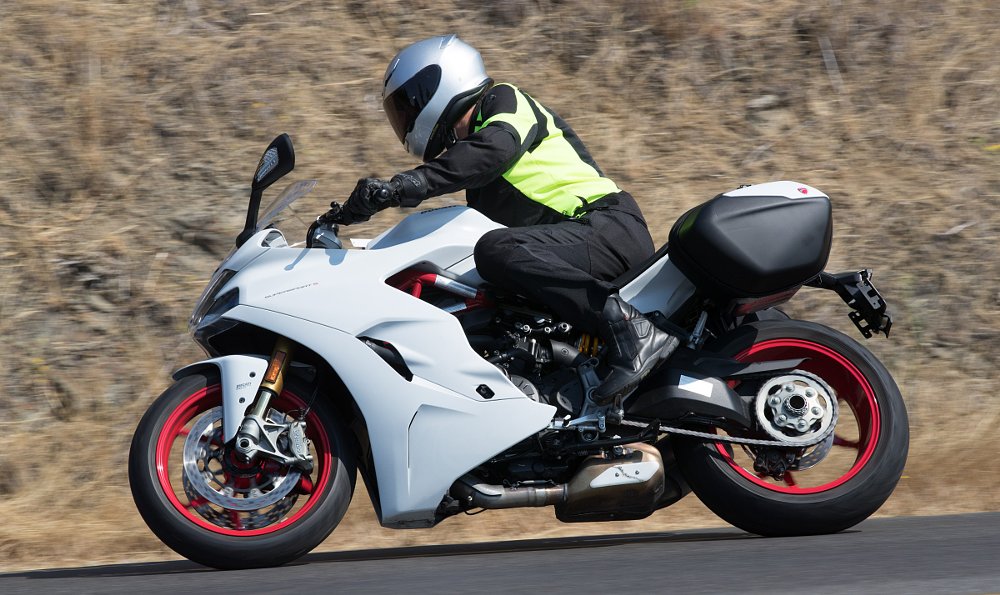
The Ducati SuperSport S is a sweet-handling motorcycle. Photo by Brian J. Nelson.
Two things you never see SuperSport owners complaining about are the bike’s looks and the handling. The Pirelli Diablo Rosso III tires that come stock on the SuperSport contribute to the sweet handling and I also like that they’re standard sizes of 120/70ZR17 front and 180/55ZR17 rear, which means when they wear out you have a huge choice of replacements, from dedicated track-day tires to long-wearing sport-touring tires.
But the bulk of the credit for the handling has to go to the Öhlins suspension. I wish I’d had the chance to try the base model SuperSport, because I’ve heard good things about its suspension, too. Though I can’t compare back-to-back and thus can’t tell you if the Öhlins pieces and the DQS are worth the $2,000 price difference, I can say the SuperSport S’s suspension is sublime. Whether pounding over freeway expansion joints, navigating bumpy city streets or whooshing along the curvy roads near the coast, the suspension just capably soaked up everything. It never felt harsh on the freeway and it never felt wallowy when I was trying to lean just a little further in the hills. And that’s despite the fact that I never even touched the settings.
Both models of SuperSports use radial-mount Brembo Monobloc M4-32 calipers and 320 mm discs in front. That’s not quite the top-spec Brembos you’ll find on the racier Ducatis, but for this hundredish-horsepower bike, they work great and provide good feedback.
The windscreen is adjustable to two positions. It’s spring-loaded, so it can be switched to high or low in a second with no tools. I didn’t feel a huge difference and neither position created any bothersome buffeting for me, so I mostly left it in the low position.
I’d sum up my experience riding the SuperSport S by saying it is a sweet-handling sport bike with power you can access in the kind of riding we do on the streets and highways of the real world and ergonomics that allow you to ride all day. I still would not hesitate to take it to a track day, either, but the SuperSport S is a sport bike that won’t punish you the 362 days a year you’re not at the track.
A few drawbacks of the Ducati SuperSport S
Overall, I really enjoyed my week on the SuperSport, but there were a few shortcomings. Some of these are general, and some may not apply to you, depending on your intended use of the bike.
Lots of readers ask about heat, and I noted that even in 69 degrees in San Francisco, I felt quite a bit of heat coming off the rear cylinder while sitting at stop lights. A common complaint among SuperSport owners is that the mirrors vibrate too much to be useful. I didn’t find them to be so bad on the particular unit I had — about par for the sport bike course, really.
The matte white paint on the bike I rode is distinctive, but some owners say it chips more easily than regular paint. And because of the matte finish, in dull light it tends to look gray. Red may be a safer choice.
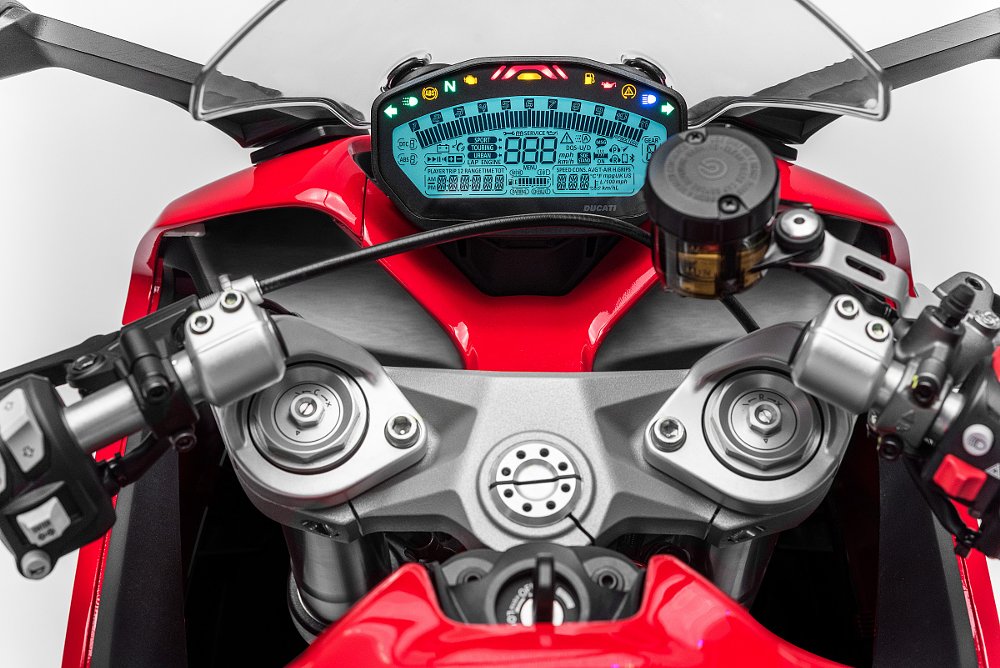
The Ducati SuperSport instrument panel packs a lot of information into a small space but is not hard to read. This photo shows every crystal lit up, so it’s misleading. The bar tach is one of the best of its kind. Ducati photo.
I suspect some riders will complain that at this price point the SuperSport S should have a TFT color dash, instead of a single-color LCD display. I thought it packed in a lot of information quite legibly, so I had no complaints.
My biggest complaint with the SuperSport S was the clutch. It worked fine once the bike was warmed up, but I stalled the bike four or five times when trying to set out for the first ride of the morning, even after I learned it needed to be feathered very, very carefully until the oil was warm. It’s a combination of a tall first gear and a narrow engagement point. It’s an annoyance, not a fatal flaw, because it’s a problem only when the engine is cold. But it was bad enough that the one day I took my wife for a two-up ride, I went out and rode around for a couple of miles to get the engine warm, because I did not want to try to take off on a cold bike with her on the back. This is another problem that seems to vary from one bike to another, as some SuperSport owners on the Ducati forums have this complaint and others don’t.
If you plan to ride the SuperSport S as the “sport bike for the street” that Ducati intended, that may be the totality of potential complaints. If you’re planning to stretch its portfolio into touring, however, as I would if I owned this bike, then you may want to think about the luggage, too.
The color-matched panniers look nice, but they do not provide the weatherproofness or security most people are looking for on multi-day rides. They are a mix of heavy fabric and hard panels and close with a zipper, so there’s no real way to make them tamper proof when you’re away from the parked bike. The bags can be removed with a key, but not the ignition key. And when you do remove the bags, the black brackets remain behind and detract from the SuperSport’s beautiful lines.
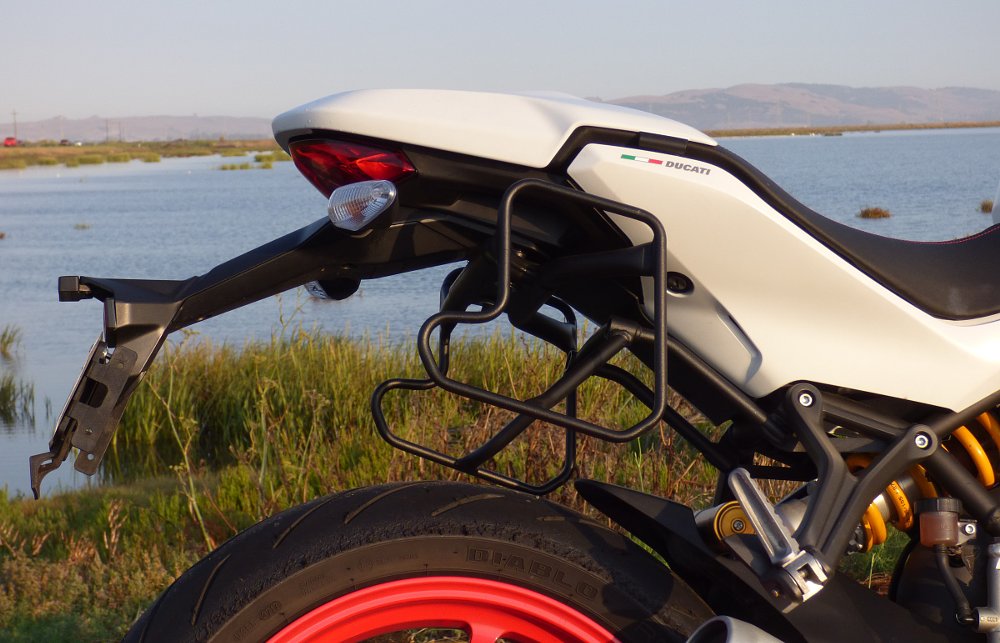
The racks that the panniers mount on are very obvious when the panniers are removed. Photo by Lance Oliver.
Those limitations would be easier to accept if the panniers didn’t cost $1,499. It’s not surprising a lot of SuperSport owners opt for aftermarket luggage solutions.
One thing that is neat about the factory panniers is that a second zipper allows for an expansion panel to open, making it possible to fit a helmet inside. Lane-splitters note, however, that in either configuration, the panniers extend wider than the narrower handgrips.
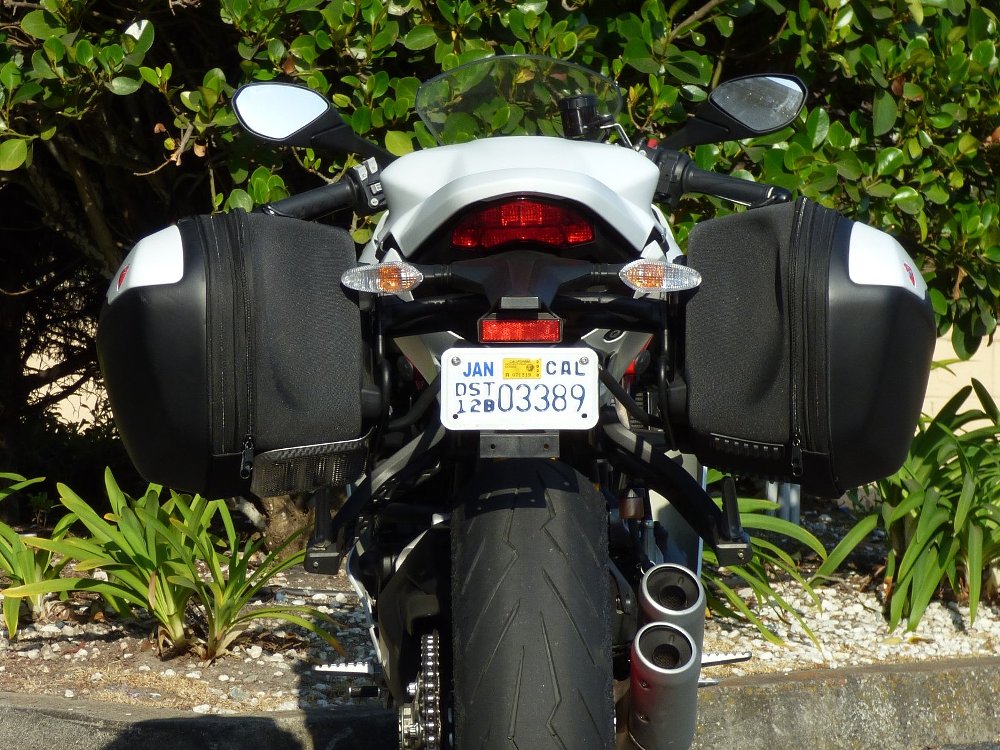
This view shows the width of the panniers when zipped closed. A gusset can be zipped open to expand them another two inches or so. That makes them wider but allows them to accommodate a full-face helmet. An observant reader noted that I had the panniers reversed. Here, you can see the right-side pannier, with the heat shield for the exhaust, is on the left side. They look better when you put them on right. Photo by Lance Oliver.
Riding the SuperSport S two-up
While I doubt many SuperSport owners plan to use the bike for any significant amount of riding with a passenger, it is worth mentioning. My wife, Ivonne, joined me for a quick getaway and we did a leisurely, 90-mile ride down the Pacific Coast Highway to Big Sur and beyond, with lots of stops for sightseeing and lunch. I removed the seat cowl that’s stock on the S (two hex-head fasteners) and the SuperSport was ready for a passenger.
Well, except for the suspension. The Öhlins shock continued to work well, but I could have used more preload. Unlike a true sport-touring bike like a Ninja 1000, the SuperSport has no remote preload adjuster. About the only tool that comes with the bike is a reversible screwdriver, and there was no way I was changing the rear preload with that. We made do.
Ivonne found the seat to be comfortable for the amount of time we were on the bike though she would have liked a better handhold. She noted the footpegs were high, but they didn’t bother her. She is five feet tall, however, and we both suspected a passenger with longer legs would have issues. Again, perspective matters. A passenger coming from a race replica will find the SuperSport comfortable. A passenger used to anything else will consider the accommodations less friendly.
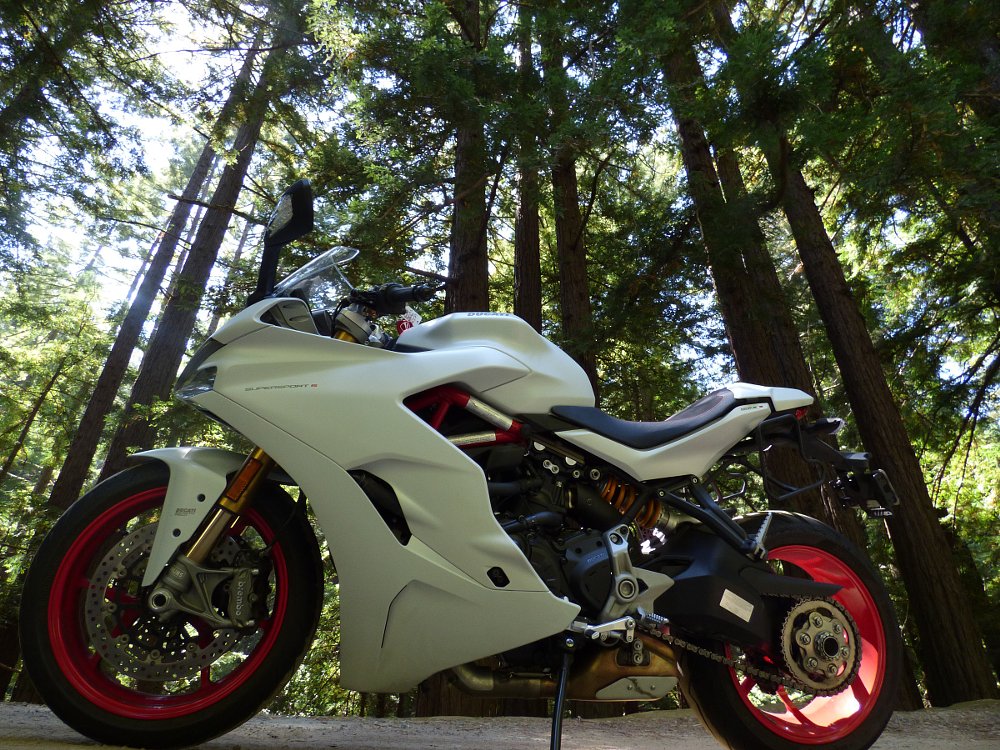
An Italian with red shoes among the California redwoods. Photo by Lance Oliver.
Where the Ducati SuperSport fits in
Talking about looks is so subjective it’s usually a waste of time in a motorcycle review. But I will say I thought the SuperSport S was a particularly attractive motorcycle from the first time I saw it. From its eyebrow daytime running lights, through its curvaceous fairing and on to the signature single-sided swingarm, the SuperSport strikes me as a beautiful bike. A lot of owners bought it for just that reason.
In addition to noticing its good looks, when I first saw the SuperSport I imagined it to be a sporty sport-tourer, but after a week riding it, I agree with Ducati: It’s best thought of as a sport bike that’s built for the street and the back roads, not just the track.
Over the years, manufacturers have improved their race replica sport bikes so much that hardly anyone buys them any more. They have become one-purpose tools, great for getting around a smooth race track or putting impressive numbers on a spec sheet, but harder to live with in the real world and requiring ever more expensive and complex electronic rider aids just to keep nearly 200 horsepower under control.
Meanwhile, even the sportiest sport-tourers, like the Ninja 1000, feel less agile. Soft-edged sport bikes like the Ninja 650 are less sophisticated and less powerful. Naked bikes offer a totally different look and riding position. All that leaves the SuperSport in a niche that may be small, but is also uncrowded.
If you’re shopping for a sporty twin and real-world ability matters more to you than a track-oriented spec sheet, I can recommend the SuperSport. It works as good as it looks.
 2018 Ducati SuperSport S |
|
| Price (MSRP) | Red: $14,995 White: $15,395 |
| Engine Type | Liquid-cooled, 90-degree twin, four valves per cylinder |
| Displacement | 937 cc |
| Bore x stroke | 94 mm x 67.5 mm |
| Power | 113 horsepower @ 9,000 rpm |
| Torque | 71.3 foot-pounds @ 6,500 rpm |
| Transmission | six gears |
| Front suspension | Öhlins 48 mm fork, adjustable preload, rebound and compression damping |
| Rear suspension | Öhlins monoshock, adjustable preload, rebound and compression damping |
| Front brake | Twin 320 mm discs, Brembo M4-32 four-piston radially mounted calipers; ABS standard |
| Rear brake | Single 245 mm disc, two-piston caliper; ABS standard |
| Tires front/rear | 120/70ZR17; 180/55ZR17 |
| Steering head angle | 24 degrees |
| Wheelbase | 58.2 inches |
| Seat height | 31.9 inches |
| Tank capacity | 4.2 gallons |
| Wet weight | 463 pounds |
